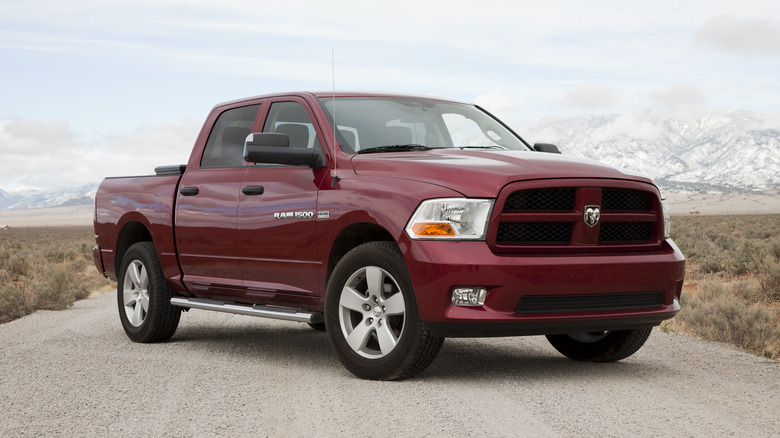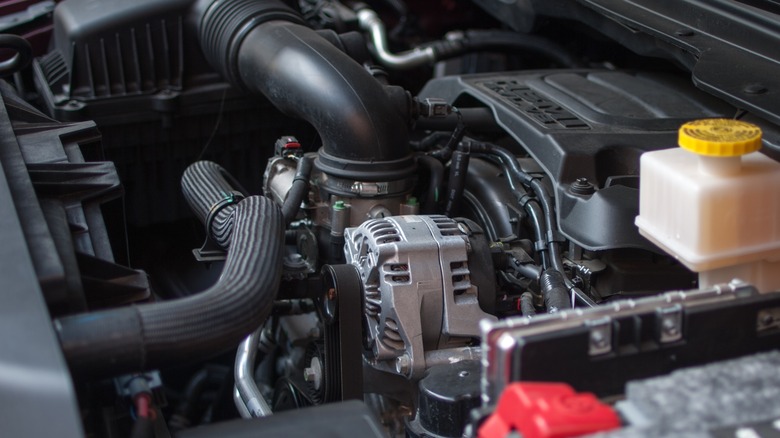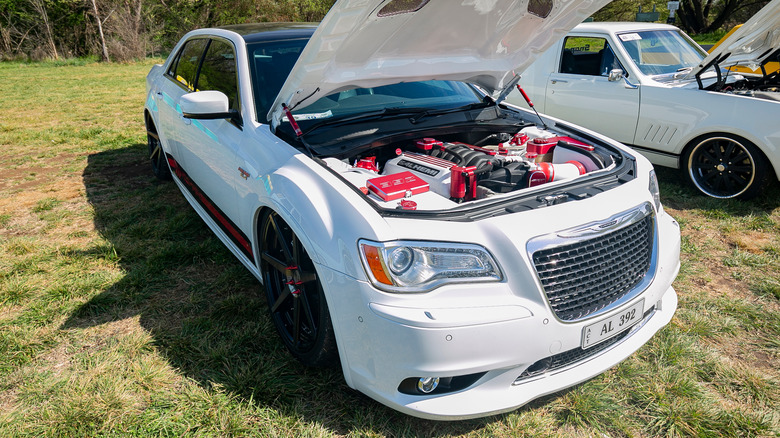Are Hemi Engines In Trucks The Same As In Chargers And Challengers?
The Chrysler HEMI is one of the most well-known, celebrated, and versatile engine series to come out of Detroit. Following WWII, Chrysler revived the hemispherical combustion chamber engine for automotive use after they fell out of fashion due to increased production costs. Hemispherical combustion chamber engines use half-sphere-shaped combustion chambers and unique pistons, which gave them an airflow advantage over early flathead engines since they can use larger intake and exhaust valves. Hemispherical engines also had better combustion efficiency, allowed for higher compression, and made more power overall. All of those factors are reasons why HEMIs remained popular amongst Mopar enthusiasts well into the 21st century.
While most people think of HEMIs as performance engines, many of the same benefits that they have as a performance engine are also beneficial for more utilitarian uses, like towing and hauling. The third-generation Chrysler HEMI proved the engine's versatility under the hood of work trucks, alongside some of Dodge and Chrysler's most notable muscle cars. The initial 5.7L HEMI was virtually unaltered regardless of its use in RAM trucks or passenger cars, while the 6.4L HEMI received a complete reworking for its truck applications. However, in both cases, the HEMIs in Chrysler trucks are more similar than they are different from the HEMIs found in Chargers and Challengers.
What are the differences between car and truck 5.7L HEMIs?
Chrysler brought back their famous HEMI formula — albeit with a different combustion chamber shape — in 2003 with the introduction of their third-generation HEMI platform, which continues to be produced to this day. The 5.7L HEMI was the first engine to be offered in the engine series and was initially released in RAM 1500, 2500, and 3500 trucks before appearing under the hood of a passenger car. After two years in service as a pickup truck and SUV engine, the 5.7L HEMI was repurposed for LX passenger cars including the Chrysler 300C, Dodge Magnum R/T, and Dodge Charger R/T. The 5.7 in RAM trucks initially made 345 horsepower, while the passenger car version made 340 to 350 horsepower, depending on the model.
For the most part, the 5.7L HEMI is identical in both trucks and passenger cars. However, since the 5.7L HEMI was used in such a wide range of vehicles of different sizes and shapes, some minor adjustments had to be made for the engine to fit in different chassis. Depending on the application, the throttle body was located either on top or in front of the intake manifold, which required a different manifold style. The exhaust manifolds are also different to conform to the packaging restraints of each chassis. Other minor differences include oil pans and accessory drives.
In 2009, the 5.7L HEMI received some important updates to utilize modern engine technology advancements. In addition to the introduction of variable camshaft timing, the update also included a revised cylinder deactivation system, called MDS by Chrysler, which shuts down cylinders in low-load situations to save fuel. While all truck applications got MDS, six-speed Challenger R/Ts didn't use the system.
What are the differences between car and truck 6.4L HEMIs?
Following the 5.7L HEMI, the 6.4L, which was introduced in 2011, was the next third-gen HEMI to be used in both Chrysler-built cars and trucks. Unlike the 5.7L HEMI, there are some very significant differences between the car and truck variants of the engine. The passenger car version, which was used in both the Challenger SRT8 and Charger SRT8 in addition to a number of other Chrysler cars and SUVs, produced between 470 and 485 horsepower. The truck version of the 6.4L HEMI was introduced in 2014 and was used in RAM 2500, 3500, 4500, and 5500 trucks, producing between 366 and 410 horsepower.
The discrepancy in power figures between the car and truck variants of the 6.4L HEMI is mainly due to the fact that the truck variant has lower 10.0:1 compression — compared to the car version's 10.9:1 – as it uses a different piston design. The truck variant also uses a different camshaft that was specifically tailored to provide better low-end torque for towing. Keeping with the theme of building the truck 6.4L HEMI around towing performance, its cylinder head is built from T356 aluminum – compared to lower grade T319 aluminum on early car variants — in order to better handle the extreme heat produced by intensive towing. The truck variants also got a thicker cast block, with a BG or BGE marking, until the car and SUV variants also began using them in 2017.
The truck 6.4L HEMI also has some notable intake and exhaust system changes compared to the car version. It uses an intake manifold with a top-mounted 80mm throttle body – in contrast to the car version's front-mounted throttle body – with different runners made to produce peak power between 3600 and 5000 rpm. On the exhaust side, the truck version received less efficient cast iron exhaust manifolds compared to the car version's tubular exhaust manifold.


